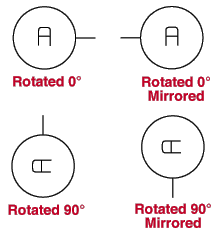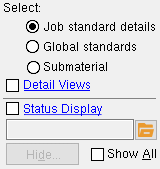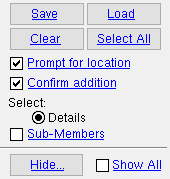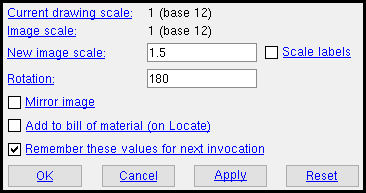 Add Standard Detail to Several ( Drawing Editor )
Add Standard Detail to Several ( Drawing Editor )
Tool summary :
Also see :
|
- Drawing Editor (where Add Standard Detail to Several is a tool)
- Layer Panel (selects layer for adding the standard detail)
- Unshorten (before performing this operation on a shortened detail)
- Verify Reference Point (resets insertion point of standard detail)
- Save Standard Detail (to save a standard detail so it can be added)
- Paste to Several (alternative to Add Standard Detail to Several )
- Undo (undoes Add Standard Detail to Several in your current drawing only)
page 1 | contents | file > | file | standard details
 Step-by-step instructions :
Step-by-step instructions :
The following instructions assume that you are using a 3-button mouse.
1a : (optional) : On the standard detail or submaterial you want to add to your current drawing, check the box for " Freeze label " on each extension dimension on that drawing (or check the box for " Freeze all dimension labels ") if you want to retain the " Label text " reported for those extension dimensions.
1b : Open a drawing that is representative of the other drawings that you want to add the standard detail to. Drawings of this same type will be in the list that appears in step 5 .
1c (optional) : On the Layer Panel, select the layer that you want to add the standard detail or submaterial detail to. This also sets the default layer for the other drawings that you place this standard detail on.
1d (if applicable) : You should Unshorten a member detail before beginning if you want Detail Members to later be able to correctly preserve ' User-created ' annotations. For best accuracy in any type of Drawing Editor drawing, measurement tools such as Dimension Add or Ruler or Construction Line Add using BSCL reliably produce precise and consistent results in an unshortened drawing.
2 . Invoke Add Standard Detail to Several using any one (1) of the following methods:
Method 1 : Click the Add Standard Detail to Several icon. The icon can be taken from the group named ' File ' and placed on a toolbar (classic) or the ribbon (lightning).
Method 2 : If " Drawing Editor layout style " is ' Classic ', you can use the menu system to choose File > Add Standard Detail to Several .
Method 3, 4 or 5 : Add Standard Detail to Several can also be invoked using a keyboard shortcut , the context menu , or a mode . For the ' Lightning ' layout style, configuration of the interface is done using Customize Interface .
3 . A drawing selection window opens.
|
The check box " Detail Views " can show or hide available detail views that are under the drawing type category '
" Status Display " and " Hide ... " and " Show All " also let you adjust the selection set that is listed when ' |
3a : Select the drawing type ('
Job standard details ' or '
Global standards ' or '
Submaterial ') that you want to be listed in the window.
3b : Double-click the name of the drawing you want (or select it, then press " OK ").
4 . A preview image of the standard detail or submaterial you selected in step 3 appears on screen along with the Add Standard Detail to Several window. Go to step 5 if you find the preview image acceptable -- to adjust the preview image, do step 4a.
4a (optional) : On the Add Standard Detail to Several window, enter the settings (rotation, scaling, etc.) that you want applied to the preview image that is shown on screen.
Tip: Use Tab to move forward or Shift + Tab to move backward from one widget to the next (or previous). As you Tab out of " New image scale " or " Scale labels " or " Rotation " or " Mirror image ," any change you make is automatically applied to the preview image.
5 . Locate- Pan -Return mouse bindings become active along with various Locate options. The image shown on screen is a preview (except for color) of how the image will look when located.
5a (optional) : Select the Locate option that you want (if it's not selected already).
5b : Place your mouse pointer (
) on screen so that the point location target snaps to the on-screen location where you want the preview image to be placed, then left-click ( Locate ).
6 . A selection dialog opens. On it is a list of drawings of the same type as your current drawing. A copy of the image is placed in your current drawing where you located it in the previous step.
|
Tip : For greatest control over the final results, both " Prompt for location " and " Confirm addition " should be checked ( |
6a : If the box for " Prompt for location " is checked (
), you are prompted to manually locate the standard detail or submaterial detail. If the box is not checked (
), the standard detail is automatically located at the coordinates defined in step 5b.
6b : If the box for " Confirm addition " is checked (
), then for each drawing you select in step 6d you get a yes-no dialog (in step 7) that gives you the option to save your changes or not. If the box is not checked (
), each drawing you select in step 6d is saved automatically as soon as the standard detail is located.
6c (optional) : Use the listing options " Hide ... " and " Show All " and " Sub-Members " to adjust which classes of drawings are shown on the selection list. " Hide ... " and " Show all " are available for both member details and submaterials. " Sub-Members " is only available for details.
6d : Select one or more drawings that you want to add the standard detail to. Press the " OK " button (or hit the Enter key) to continue.
7 . One of the following takes place:
Possibility 1 : You are prompted to locate the standard detail (because you checked the box in step 6a ). By default, the selected layer is a layer of the same name as the layer you selected in step 1b (if such a layer exists). If there is no such layer, the default layer is the ' User annotation ' layer. This applies to each of the drawing(s) selected in step 6d . Tip : With possibility 1 you have the option to Unshorten each drawing, or select a different layer, or change the image's settings (rotation, scale, etc.) before you place it on each drawing.
Possibility 2 : The standard detail is placed automatically (see step 6a ) in the drawing(s) you selected in step 6d. If the drawing has a layer of the same name as that selected in step 1b , the standard detail is automatically placed on that layer. If the drawing does not have a layer of that same name, Add Standard Detail to Several creates a new layer of the same name and automatically places the standard detail on that layer.
8 . When you (or Add Standard Detail to Several ) are done placing a copy of the standard detail on each of the drawings selected in step 6d , your current drawing is reactivated. If you did not check the box for " Confirm addition ," any changes made to drawings selected in step 6d are saved automatically.
Tip: The standard detail placed using this procedure can be removed from your current drawing by using Undo . You cannot, however, automatically remove the standard detail from the other drawings it was placed in.
Note: Add Standard Detail to Several does not automatically place standard details on a drawing that is being used by another user. It skips that drawing.
page 1 | contents | file > | file | standard details | top
 The Add Standard Detail to Several window :
The Add Standard Detail to Several window :


bindings
Current drawing scale: read-only . This tells you the scale of the drawing you are importing the image to. In other words, this is the scale of your current drawing or of a drawing you selected in step 6d .
Image scale: read-only . This tells you the scale of the standard detail or submaterial you are placing copies of (selected in step 3 ).
New image scale (Base 12 or Base 10) : The scale you want applied to the preview image. The scale is applied immediately (when you press Tab or " Apply "). To locate the preview image, see step 5 and/or step 7, possibility 1 .
(Base 12) means imperial dimensioning is being used. Enter the number of inches on your current drawing that you want to represent 1 foot in the shop or construction site.
(Base 10) means metric dimensioning is being used. Enter the number of millimeters on your current drawing that you want to represent 10 mm on the actual materials.
Objects not affected by " New image scale ": The sizes of labels , piecemarks , section sizes , pointer arrowheads , dimension terminals (
) and workpoint symbols are independent of the " New image scale ." The sizes of labels and dimension labels can be changed using "
Scale labels " (below) or on their edit windows. Other objects that are independent of scaling can also be resized using their edit windows.
Tip: You may want to make the " New image scale " match the " Current drawing scale ." Note that if you enter a new scale here, you can also choose to " Scale labels ." For more information, see " Drawing scale ."
Defaults: The next time you do an entirely new Add Standard Detail to Several operation, the " New image scale " defaults to the " Image scale ." You can, however, use " Remember these values " (followed by " Apply " or " OK ") to apply this scale to each copy of the image you locate during the current operation.
Scale labels: ![]() or
or ![]() . This applies only if you changed the " New image scale ." The scale is applied to the preview image immediately (when you press Tab or " Apply "). To locate the preview image, see step 5 and/or step 7, possibility 1 .
. This applies only if you changed the " New image scale ." The scale is applied to the preview image immediately (when you press Tab or " Apply "). To locate the preview image, see step 5 and/or step 7, possibility 1 .
If this box is checked (
), the labels and dimension labels on the preview image are scaled per the " New image scale ." The label " Font size " and dimension label " Font size " reported on the located objects' edit windows will be changed in correlation with the new scale.
If the box is not checked (
), the labels on the preview image remain at the " Image scale ."
Rotation: Any positive or negative (-) angle from 360 to - 360 degrees. The rotation is applied to the preview image immediately (when you press Tab or " Apply "). To locate the preview image, see step 5 and/or step 7, possibility 1 .

' 0 ' (zero) degrees reverts the preview image to its rotation in its drawing file. In other words, the preview image keeps the rotation it had when it first appeared in step 4 .
A ' positive number ' rotates the preview image counterclockwise that number of degrees.
A ' negative (-) number ' rotates the preview image clockwise that number of degrees.

If this box is checked (
), the preview image is made a mirror image of itself. A mirror image is one in which right and left are reversed.
If the box is not checked (
), the preview image remains oriented as it is oriented in its actual drawing file (as it first appeared in step 4 ).
Defaults: The next time you do an entirely new Add Standard Detail to Several operation, " Mirror image " defaults to off (not checked). You can, however, use " Remember these values " (followed by " Apply " or " OK ") to mirror each copy of the image you locate during the current operation.
Add to bill of material (on Locate): ![]() or
or ![]() . This is for adding bill info to a member detail or detail sheet. It does not appear as an option when there is no bill info or your current drawing is something other than a member detail or detail sheet. On a member detail or detail sheet, this is disabled (grayed out) if there is no bill information in the standard detail. Only the lines after line 1 in the standard detail are copied.
. This is for adding bill info to a member detail or detail sheet. It does not appear as an option when there is no bill info or your current drawing is something other than a member detail or detail sheet. On a member detail or detail sheet, this is disabled (grayed out) if there is no bill information in the standard detail. Only the lines after line 1 in the standard detail are copied.
If this box is checked (
), the bill information associated with the drawing selected in step 3 is merged with the bill of material of your current drawing when you left-click ( Locate ) in step 5 (or in step 7, possibility 1 ). The standard detail's bill information is positioned in the drawings's bill after all other materials and before field bolts. To review this bill of material information, use Edit Bill .
If the box is not checked (
), the bill information associated with the located image does not get merged with the bill of material of the drawing in which it is located.
Remember these values for next invocation: ![]() or
or ![]() . This affects whether or not the settings on this window are remembered during your current Add Standard Detail to Several operation. For the next Add Standard Detail to Several operation, it affects whether or not all settings except " Mirror image " or " New image scale " are remembered.
. This affects whether or not the settings on this window are remembered during your current Add Standard Detail to Several operation. For the next Add Standard Detail to Several operation, it affects whether or not all settings except " Mirror image " or " New image scale " are remembered.
If this box is checked (
) and you press " Apply " or " OK ," all settings on this window will be remembered when this window opens again in the next drawing that you select to place this standard detail in. The settings (except " Mirror image " or " New image scale ") will also be remembered when the next Add Standard Detail to Several operation starts.
If the box is not checked (
) and you press " Apply " or " OK ," the settings on this window will, after you left-click ( Locate ) the preview image, revert to the basic default settings . If you end this operation, the next Add Standard Detail to Several operation starts with the basic default settings.
-------------------------
"OK" (or the Enter key) closes this window, but does not end the operation. The preview image remains on screen, and Locate- Pan -Return mouse bindings are active.
Note 1: You do not have to close this window in order to proceed with the operation. You can left-click ( Locate ) the preview image with the window still open. You can also right-click ( Return ) with the window still open. See step 5 or step 7, possibility 1 .
Note 2: With respect to " Remember these values ," " OK " works the same way as " Apply ." See the discussion about defaults under " Apply ."
"Cancel" (or the Esc key or the ![]() button) closes this window.
button) closes this window.
On your original drawing: " Cancel " closes this window and ends the operation. The preview image disappears.
On another drawing: " Cancel " closes this window, cancels the placing of the standard detail in that drawing, and opens the next drawing.
"Apply" updates the preview image with the current setting for the field that you are in (" New image scale " or " Rotation " or etc.) without your having to Tab out of that field.
Defaults for your current Add Standard Detail to Several operation: If you press " Apply " (or " OK ") and " Remember these values " is checked, all of the current settings will be retained on the Add Standard Detail to Several window after you left-click ( Locate ) the preview image.
Defaults for your current Drawing Editor session: If you press " Apply " (or " OK ") and " Remember these values " is checked and you later end this operation without changing any settings in the meantime, the current settings except " Mirror image " and " New image scale " will be retained for the next Add Standard Detail to Several operation during your current Drawing Editor session.
" Reset " reverts the settings on the Add Standard Detail to Several window back to the basic default settings that apply when Add Standard Detail to Several is first invoked during a new session in the Drawing Editor .
Basic default settings: " New image scale " is made to match the " Image scale ." " Rotation " is set to ' 0 '. " Mirror image " and " Remember these values " are unchecked. " Add to bill of material " is checked if the standard detail includes bill information and the drawing you are adding it to is a member detail or detail sheet.
page 1 | contents | file > | file | standard details | top










